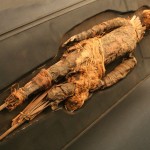Beliefs and funeral rites
The Chinchorro culture offers the earliest complex expression of a cult of the dead and ancestor worship on the arid South American coast. This is seen through the complicated mummification process, which involved extracting the muscles and internal organs of the deceased person and replacing these with plants, feathers, pieces of leather, wool fleece and other material. The body was then covered with a layer of clay and a wig made of human hair was placed on the head. The Chinchorro mummification process evolved through several stages: Initially, they mummified only infants and children, adorning them with vibrant colors and placing clay figurines with them. At the zenith of Chinchorro culture, around 3000 BC, all members of society were mummified (men, women, and children of all ages), smeared with a thick layer of red, black or brown pigment. In the final days of this culture, the mummies bore only mud masks. The mummies were apparently not buried but were stood upright in a visible location in the camp, perhaps to indicate the group’s lineage from a common ancestor. In addition, not all members of Chinchorro bands were mummified; some were buried in simple graves. Such graves have been found on elevated terraces and containing one or more individuals who may have been family groups.




